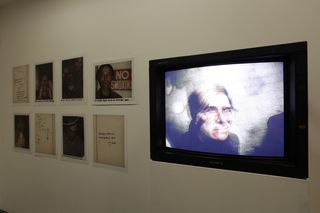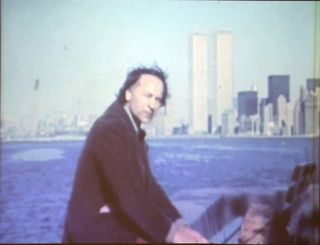by Sue Hubbard
 How do we remember? Before the invention of the camera most people never possessed a likeness of themselves or those they loved – a lock of hair, a letter, were the heart’s most treasured possessions, the artefacts that conjured the past. Photography democratised the ownership of images. A portrait need no longer be in watercolour or oils, it could be an informal snap taken on a box Brownie: a casual moment sealed in the proverbial amber of memory. With the technological advances of the 20thand 21st centuries, with film, video and digital technology and the predominance of surveillance equipment it might, theoretically, be possible to record a whole life from the moment of birth till the second of death. It was only a decade or so ago that the French Postmodernist social theorist Jean Baudrillard argued that the images which assault us – on our TVs, in film and advertising – are not copies of the real, but become truth in their own right: the hyperral. Where Plato had spoken of two kinds of image-making: the first a faithful reproduction of reality, the second intentionally distorted in order to make a copy appear correct to viewers (such as a in a painting) Baudrillard saw four: the basic reflection of reality; the perversion of reality; the pretence of reality, and the simulacrum, which “bears no relation to any reality whatsoever”. Baudrillard's simulacra were, basically, perceived as negative, but another modern French philosopher, Gilles Deleuze, has described simulacra as the vehicle by which accepted ideals or a “privileged position” can be “challenged and overturned”. Reality has become a complex issue.
How do we remember? Before the invention of the camera most people never possessed a likeness of themselves or those they loved – a lock of hair, a letter, were the heart’s most treasured possessions, the artefacts that conjured the past. Photography democratised the ownership of images. A portrait need no longer be in watercolour or oils, it could be an informal snap taken on a box Brownie: a casual moment sealed in the proverbial amber of memory. With the technological advances of the 20thand 21st centuries, with film, video and digital technology and the predominance of surveillance equipment it might, theoretically, be possible to record a whole life from the moment of birth till the second of death. It was only a decade or so ago that the French Postmodernist social theorist Jean Baudrillard argued that the images which assault us – on our TVs, in film and advertising – are not copies of the real, but become truth in their own right: the hyperral. Where Plato had spoken of two kinds of image-making: the first a faithful reproduction of reality, the second intentionally distorted in order to make a copy appear correct to viewers (such as a in a painting) Baudrillard saw four: the basic reflection of reality; the perversion of reality; the pretence of reality, and the simulacrum, which “bears no relation to any reality whatsoever”. Baudrillard's simulacra were, basically, perceived as negative, but another modern French philosopher, Gilles Deleuze, has described simulacra as the vehicle by which accepted ideals or a “privileged position” can be “challenged and overturned”. Reality has become a complex issue.
 Jonas Mekas was 90 on Christmas Eve, which means that the film-maker, artist and poet, often referred to as the godfather of avant garde cinema, has lived through a lot of history. Born in Lithuania he spent part of the war in a forced labour camp, then after the hostilities ended, another four years in various displaced person’s camps such as Flensburg, Hamburg, Wiesbaden, Kassel – first in the British Zone, then in the American. With nothing much to do and a lot of time he read, he wrote and went to the movies, which were shown free in the camps by the Americans. So began his long relationship with film. Later, when he commuted to the French Zone to study at the University of Mainz, he met André Gide who told him to “work only for yourself,” and watched a lot of French cinema. After arriving in America he bought his first Bolex camera in 1950, which he used to film everyday scenes in Williamsburg, Brooklyn, and the Lithuanian immigrants who lived there. Describing himself and his brother as “two shabby, naïve Lithuanian boys, just out of forced labour camp”, it was not until some 10 years later that he decided to assemble the footage into a film.
Jonas Mekas was 90 on Christmas Eve, which means that the film-maker, artist and poet, often referred to as the godfather of avant garde cinema, has lived through a lot of history. Born in Lithuania he spent part of the war in a forced labour camp, then after the hostilities ended, another four years in various displaced person’s camps such as Flensburg, Hamburg, Wiesbaden, Kassel – first in the British Zone, then in the American. With nothing much to do and a lot of time he read, he wrote and went to the movies, which were shown free in the camps by the Americans. So began his long relationship with film. Later, when he commuted to the French Zone to study at the University of Mainz, he met André Gide who told him to “work only for yourself,” and watched a lot of French cinema. After arriving in America he bought his first Bolex camera in 1950, which he used to film everyday scenes in Williamsburg, Brooklyn, and the Lithuanian immigrants who lived there. Describing himself and his brother as “two shabby, naïve Lithuanian boys, just out of forced labour camp”, it was not until some 10 years later that he decided to assemble the footage into a film.
Read more »
It is said that the camera never lies – but that was before things went digital. At the Victoria Miro Gallery, Stan Douglas has created a number of disturbingly hyperreal images with the use of digital technology that give the illusion of documentary accuracy. These theatrical black and white mise en scènes explore the seedy underbelly of post-war North America before what the artist describes “as the sudden call to order and morality” that was achieved by peacetime prosperity. Based on archival photographs a hotel used to house World War II veterans has been transformed into The Second Hotel Vancouver, 2014, an uncanny image where Piranesi seems to meet Edward Hopper.
